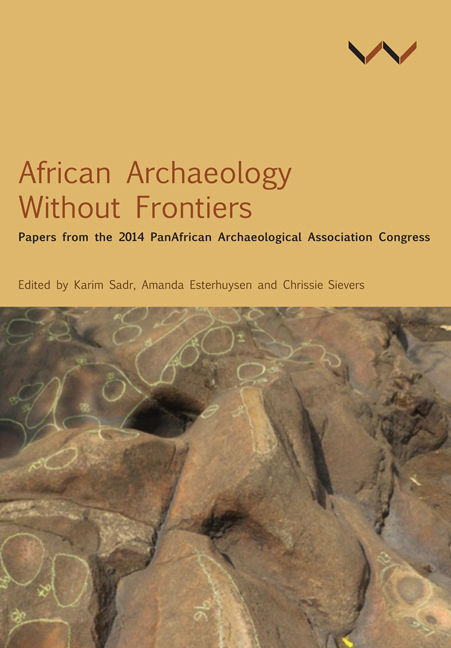 African Archaeology Without Frontiers
African Archaeology Without Frontiers Book contents
- Frontmatter
- Contents
- Acknowledgements
- List of Figures and Tables
- Introduction: An Invitation Fulfilled
- Keynote Address 1: Imagining an African Archaeology Without Frontiers
- Keynote Address 2: A Continental Vision for African Archaeology
- 1 The ‘Useable’ Archaeology of African Farming Systems
- 2 Defining Cultural Heritage among the Makonde of Tanzania
- 3 The Indigenous Roots of Swahili Culture in Pangani Bay, Tanzania
- 4 Is This an Anvil? Iron Bloom Crushing Sites in Northern Togo
- 5 L'art Rupestre au Cameroun, Nouvelles Découvertes et Contribution à L'iconographie Sous-Régionale
- 6 Archaeology and History in Iron Age Settlements in the Congo Basin
- 7 Learning from Glass Trade Beads at Thabadimasego, Botswana
- 8 Blurring Boundaries: Forager–Farmer Interactions in the Middle Limpopo Valley
- 9 Heritage Management and the World Wide Web: South African Challenges
- Contributors
- Index
8 - Blurring Boundaries: Forager–Farmer Interactions in the Middle Limpopo Valley
Published online by Cambridge University Press: 15 March 2018
- Frontmatter
- Contents
- Acknowledgements
- List of Figures and Tables
- Introduction: An Invitation Fulfilled
- Keynote Address 1: Imagining an African Archaeology Without Frontiers
- Keynote Address 2: A Continental Vision for African Archaeology
- 1 The ‘Useable’ Archaeology of African Farming Systems
- 2 Defining Cultural Heritage among the Makonde of Tanzania
- 3 The Indigenous Roots of Swahili Culture in Pangani Bay, Tanzania
- 4 Is This an Anvil? Iron Bloom Crushing Sites in Northern Togo
- 5 L'art Rupestre au Cameroun, Nouvelles Découvertes et Contribution à L'iconographie Sous-Régionale
- 6 Archaeology and History in Iron Age Settlements in the Congo Basin
- 7 Learning from Glass Trade Beads at Thabadimasego, Botswana
- 8 Blurring Boundaries: Forager–Farmer Interactions in the Middle Limpopo Valley
- 9 Heritage Management and the World Wide Web: South African Challenges
- Contributors
- Index
Summary
Abstract
Increases in farmer social complexity and the development of state-level society in southern Africa appeared first in the middle Limpopo Valley. The various social, political and economic changes that led to the establishment of the Mapungubwe state were witnessed by an incumbent forager community who practised a hunting and gathering way of life. This paper presents new findings indicating that some foragers shifted their lifeways beginning around AD 1000 when they began occupying farmer homesteads and presumably taking part in food production. At two sites, João Shelter (AD 900–1300) and Kambaku Camp (AD 1480–1650), the different phases of forager assimilation into a farmer system are archaeologically observable. Initially, settlement shifts appear to have been limited and foragers may have occupied João alongside farmers on a temporary basis or only performed certain activities at the site. However, at Kambaku it seems that foragers more fully integrated into the farmer system, maintaining only certain parts of their material culture, such as the production of stone tools. Additionally, Kambaku challenges previous findings made in the area that recorded a disappearance of the Later Stone Age material record around AD 1300. The results presented here demonstrate the varied outcomes from forager–farmer interactions and the gradual shift in forager residential patterns and mobility favouring sedentism in the middle Limpopo Valley.
Introduction
The final stages of southern Africa's Later Stone Age (LSA) are poorly understood (Hobart 2004). Generally, archaeologists focus on the pre-ceramic levels of the LSA, which are well preserved and have not, like the upper levels in many rock shelters, been disturbed by domesticated animals. Instead, the last 2 000 years are often lumped into broad categories (for example, Lombard et al. 2012), homogenising the great degree of diversity recorded in many studies across southern Africa (such as Mazel 1989; Hall 1994; Walker 1994; Van Doornum 2005; Van der Ryst 2006; Forssman 2014a, b). Much of this variability was the result of contact between foragers and farmers and one outcome from these interactions, which is the focus of this paper, was a shift in forager settlement patterns (see Moore 1985; Hall & Smith 2000). It seems odd, then, that archaeologists use their findings from rock shelters to draw conclusions relating to interactions between foragers and farmers, yet at the same time acknowledge a shift in forager campsite choices.
- Type
- Chapter
- Information
- African Archaeology Without FrontiersPapers from the 2014 PanAfrican Archaeological Association Congress, pp. 143 - 164Publisher: Wits University PressPrint publication year: 2016
